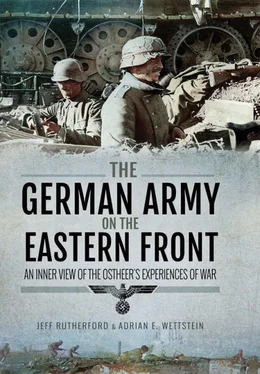b) Local Commandant – Pleskau [Pskov] area
On the eastern border of the local commandant area and in the area of the adjacent neighbouring divisions, large joint actions were commenced against the strong gangs that had cropped up. Gangs were repeatedly met. The bandits suffered considerable casualties in dead and wounded during combat. In this way, the gangs dispersed and withdrew to the north and northeast. At the end of the report period, no gangs were noticeable in the area.
Incursions of enemy aircraft and bombings have increased. Pleskau [Pskov] was bombed multiple times. Negligible damage to the south airfield and the train station. Numerous large fires have been noted in Pleskau [Pskov], including one in which a large garage burned down. Causes of the individual fires have not yet been determined. Presumably sabotage, investigations are underway.
In Detail:
I) Estonia:
Paratrooper taken prisoner: 2
Paratrooper shot: 1
Gang helper, already reported, shot after conclusion of interrogation: 4
Sabotage or thievery of telephone wires: 8
Parachutes with loaded bags observed: 2 […]
Balloons armed with explosives: 2 […]
Bombings: 2 […]
Fires: 1 (in Värska where 26 horses burned to death, 12 were severely injured and 19 were lightly injured)
In addition, a fire in the oil shale plant Kiviolo. Cause: gross negligence of the worker proven
II) Russian Area:
Firefights: 16 (of which four were [partisan] attacks)
Gang members shot in battle: 25
Gang members taken prisoner: 7
Gang members, already reported, shot after the conclusion of their interrogation: 21 (includes 6 members of the earlier reported 17 member terror organization Gdov; 7 of these were given to the SD and 4 were released)
Civilians shot due to crimes: 4
Own losses: Dead: 3 (Estonians), Wounded: 7 (1 German, 2 Estonians, and 4 EKA [local combat section]
Captured Goods: 4 sub-machine guns, 1 light machine gun, 1 rifle (German), 6 rifles, 15 hand grenades, 900 rounds rifle ammunition, 15 pairs of skis and explosives
Rail detonations: 1
Thwarted rail detonations: 3
Bombing raids: 17 (of which 12 on Pleskau [Pskov])
In which dead: 1
Wounded: 4 (2 German soldiers)
Fires: 7 (during a fire in a large garage, 12 trucks were burned up with 2 trailers and communication equipment)
As the document indicates, German rear-area formations spent much of their time securing economic installations and resources, in addition to their more proactive patrols and raids on real and suspected partisan camps. While many of the army’s anti-partisan operations during the war proved to be nothing more than murderous actions that targeted civilians and created ‘dead zones’ in which nothing remained that could support an insurgency, the 207th Security Division clearly engaged an actual enemy in northwest Russia. Equally clearly, the division neither waged a brutal war of extermination against partisans and their supporters, nor did it attribute every accident to a ubiquitous insurgency. Its treatment of captured partisans, however, spoke to the general attitude towards Soviet civilians that permeated the army.
While the fight against insurgents constituted the primary task for rear-area units, frontline units were also frequently forced to carry out missions against partisan units in their rear in order to secure their lines of communication. The following order issued by the 126th Infantry Division in December 1943 highlighted the seriousness with which the army approached partisan war. The German way of war emerges in this document, with its emphasis on decisive leadership, the importance of speed and mobility, and the necessity of destroying the enemy’s means of survival. [46]
Advice for the Partisan Hunt
1) Only the active partisan hunt leads to success. Decisive and energetic NCOs are to be divided as leaders of the hunt patrols. They receive their orders from the division or the town commandant.
2) The hunt patrol follows the same tactics as the bandit. It never goes on streets and never through villages; rather it goes aside from these through forest and swamp. Every movement has to take place silently. It can only work with signals and whispered speech. The patrols also never go on the same path as the day before. They scout out bandit paths and trails and [then observe by] listen[ing] in on them.
3) All remote lying huts, hide outs and earthen bunkers that could offer the bands shelter are to be destroyed by the patrols. Everything that could support life must be taken from the bandits.
4) Attire and equipment for the patrols must be adjusted to their mission. Everything that is unnecessary is to be left behind. Weapons and equipment are to be worn so that they don’t rattle (see item 2). With increasing depth of snow, the patrols must be able to move on skis.
5) The bandit always has the carelessness of the German soldier to thank for his success. When he can avoid it, he doesn’t fight. When he receives surprising fire, he almost always scampers off; the same thing when he realizes that the opponent that he meets is prepared for defence. All patrols must have their weapons ready to fire at all times. When advancing near bandits, fire cover is especially important.
6) When the patrol ambushes a bandit troop, it must know that almost always the bandit leader marches in the front; in the second position is generally the Politruk. What marches behind the bandit [leaders] is generally not important.
The bandit loves flanking manoeuvres; he often only apparently retreats. Therefore security for the flanks!
A further piece of German occupation policy in 1943 – one that was closely connected with its anti-partisan and labour mobilization policies, as well as its scorched earth retreats – was its increasing use of forced evacuations of Soviet communities. In all three cases, the Germans wanted to both deny the Soviets’ – the Red Army or partisans – manpower and use that same manpower for its own purposes. By this point in the war, the evacuation of civilians had become part of German combat divisions’ everyday activities. As this order issued by the 7th Infantry Division in preparation for its participation in the ‘Buffalo Movement’ – the scorched earth retreat out of the Rzhev salient – indicates frontline divisions were intimately involved with this aspect of German occupation practice. [47]
1) It is planned to evacuate:
a) workers between 13 and 50 years old preferably without dependents.
b) local auxiliary police and all those people in service and interests of the Wehrmacht and their dependents
c) the population on both sides of the new position, namely 15km east of it and 5km west of it
2) All evacuees are to be left cattle and foodstuffs so long as they can carry it on the marches. In particular, all available horses, sleds and wheeled vehicles are to be left to the civilians for the transport of foodstuffs and the necessary household goods.
3) Male inhabitants, who appeared to be suitable as Hilfswillige , can be kept with the troops. After a probationary period, they can transfer into the Hilfswillige units, as long as they have already declared for it.
4) All food stocks, so long as they cannot be definitely allocated among the troops, are to be used to provide the population being evacuated with food for the march. The sections of the population remaining in their villages are only to be left the absolute minimum.
The evacuated population is to be left livestock (milk cows and small livestock) to secure their supply during the march and in their new area, while the section of the population left behind is allowed only a few milk cows for the supply of milk for children and the sick.
Читать дальше






![John Stieber - Against the Odds - Survival on the Russian Front 1944-1945 [2nd Edition]](/books/405234/john-stieber-against-the-odds-survival-on-the-russian-front-1944-1945-2nd-edition-thumb.webp)





